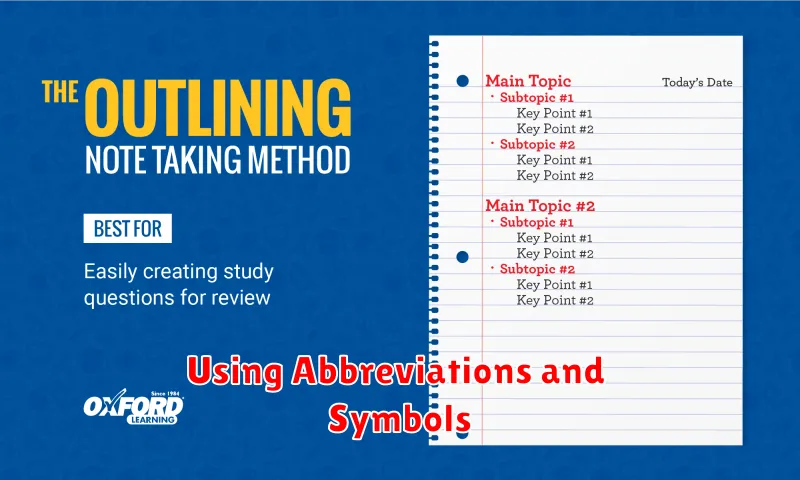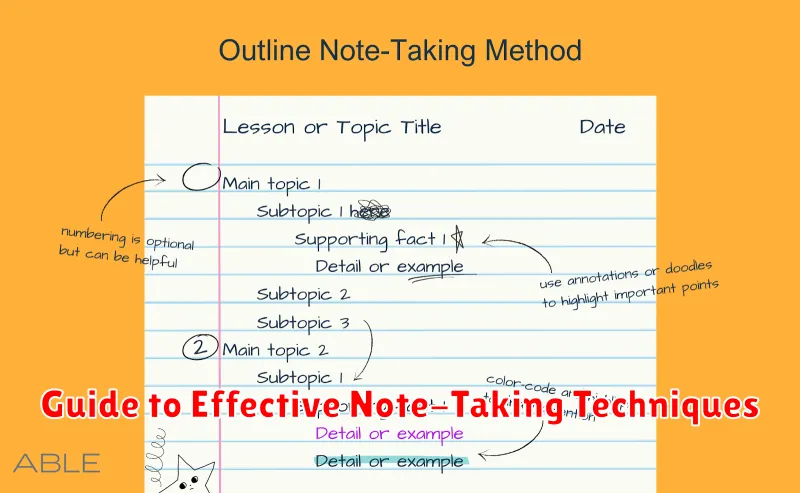Effective note-taking is a critical skill for academic success, professional development, and personal growth. Whether you’re a student striving for top grades, a professional aiming to absorb key information from meetings, or an individual seeking to retain knowledge from books and lectures, mastering effective note-taking techniques can significantly enhance your learning and productivity. This guide will explore a variety of note-taking techniques, offering practical strategies and tips to help you develop a system that works best for your individual needs and learning style. From traditional methods like the Cornell Method and outlining, to more contemporary approaches like mind mapping and sketchnoting, you will discover how to effectively condense and organize information, making it readily accessible for review and recall. Understanding the importance of note-taking is the first step toward unlocking your learning potential.
Developing effective note-taking habits is an investment in your future success. Note-taking isn’t simply about scribbling down words; it’s about actively engaging with the material, synthesizing information, and creating a personalized resource for later review. This guide provides a comprehensive overview of various note-taking methods, offering insights into their strengths and weaknesses, and guiding you towards choosing the best approach for different learning contexts. Learn how to identify key concepts, use abbreviations and symbols efficiently, and structure your notes for optimal comprehension and retention. By implementing the techniques discussed in this guide, you can transform your note-taking from a passive activity to a powerful tool for learning and achievement.
Choosing the Right Note-Taking Method
Selecting an effective note-taking method is crucial for maximizing learning and retention. The “best” method depends on individual learning styles, the type of material, and the context. Experimentation is key to finding what works best for you.
Consider factors such as your comfort level with technology, the pace of the lecture or meeting, and the complexity of the subject matter.
Some popular methods include the Cornell Method, sketchnoting, linear note-taking, and mind mapping. Each offers distinct advantages and disadvantages.
Organizing Your Notes Clearly
Clear organization is essential for effective note-taking. Disorganized notes are difficult to review and hinder effective learning.
Choose an organizational method that suits your needs and learning style. Some popular methods include:
- The Cornell Method: Dividing your page into sections for notes, cues, and summaries.
- The Outline Method: Using headings and subheadings to structure information hierarchically.
- The Mapping Method: Visually connecting key concepts and ideas.
Regardless of your chosen method, ensure your notes are legible and use consistent formatting. This includes clear headings, bullet points, and abbreviations where necessary.
Active Listening Strategies
Active listening is crucial for effective note-taking. It involves fully concentrating on the speaker, understanding the message, and responding thoughtfully. It’s more than just hearing; it’s about engaging with the information.
Some key strategies include: paying attention not only to the words but also to the speaker’s body language and tone of voice. Asking clarifying questions is essential for understanding complex concepts. Summarizing main points throughout the lecture helps solidify understanding. Avoiding distractions such as electronic devices or side conversations helps maintain focus. Finally, organizing information mentally as you listen prepares you for effective note-taking.
Using Abbreviations and Symbols

Abbreviations and symbols are powerful tools for concise note-taking. They save time and space, allowing you to capture more information quickly. Consistency is key for effective use. Create a personal key for your abbreviations and symbols so you can easily decipher your notes later.
Some common examples include:
- w/ for “with”
- & for “and”
- e.g. for “for example”
- i.e. for “that is”
- * to denote importance
Develop your own shorthand for commonly used words and concepts relevant to your studies or work. Avoid overly complex or obscure abbreviations that you might forget.
Reviewing Notes Regularly
Regular review is crucial for retaining information gathered through note-taking. Consistent review strengthens memory and facilitates deeper understanding of the material.
Spaced repetition is a highly effective review technique. This involves reviewing notes at increasing intervals. For example, review after one day, then three days, then a week, and so on. This combats the forgetting curve and promotes long-term retention.
Active recall is another powerful method. Instead of passively rereading notes, try to recall the information from memory first. Then, check your notes to identify any gaps or inaccuracies. This strengthens retrieval pathways and enhances understanding.
Digitizing Your Notes
In today’s digital age, digitizing your notes offers numerous advantages. It allows for easy organization, searching, and backup. Various methods exist for digitizing handwritten notes, including using a scanner, taking photographs, or utilizing a digital pen and notebook.
Directly typing notes on a laptop or tablet offers immediate digitization. Note-taking applications provide features like tagging, cloud syncing, and multimedia integration.
Choosing the right method depends on personal preference and workflow. Consider factors like the volume of notes, need for handwriting, and desired features.
Mind Mapping for Complex Topics
Mind mapping offers a powerful visual approach to note-taking, especially beneficial for dissecting complex subjects. It allows you to organize and connect ideas in a non-linear fashion, mirroring the way your brain naturally processes information.
Start with the central topic at the core of your map. From there, branch out to main ideas, using keywords and short phrases. Further sub-branches can then capture supporting details and examples, creating a radiating structure that visually represents the relationships between concepts.
This technique encourages active recall and helps identify connections that might be missed in linear note-taking methods. It’s a highly effective tool for brainstorming, summarizing information, and preparing for presentations or exams.
Highlighting Key Points Efficiently
Highlighting is a crucial aspect of effective note-taking. It allows you to quickly identify important information when reviewing your notes later. However, over-highlighting can be counterproductive, essentially making everything equally important and thus, nothing important.
The key is to be selective. Focus on highlighting only the most crucial information, such as key terms, definitions, dates, formulas, and main ideas. Avoid highlighting entire sentences or paragraphs. Instead, aim to highlight individual words or short phrases that capture the essence of the concept.
Develop a consistent highlighting system. For example, you might use one color for key terms, another for dates, and a third for important concepts. This system will help you visually organize your notes and quickly locate specific information when needed.
Combining Lecture and Reading Notes
Integrating lecture and reading notes creates a comprehensive understanding of the subject matter. This approach allows you to connect concepts discussed in class with the broader context provided in your readings. It also reinforces learning by revisiting the material in different formats.
Several methods can be employed to effectively combine these notes. One popular method is the Cornell Note-Taking System, which provides a dedicated section for integrating and summarizing key points. Another method involves creating a separate document or section where you synthesize information from both sources, drawing connections and identifying areas where your lecture and reading materials support or contradict each other.
Avoiding Common Note-Taking Mistakes

Effective note-taking is crucial for retention and understanding. However, common pitfalls can hinder this process. Avoid passively transcribing everything. Instead, actively listen and synthesize information. Focus on key concepts and arguments.
Another frequent mistake is neglecting to review notes. Regular review reinforces learning and identifies gaps in understanding. Consistent review is essential for effective note-taking.
Finally, avoid disorganized notes. A clear structure with headings and subheadings makes information retrieval easier. Employing a consistent organizational strategy, whether it be the Cornell Method, outlining, or mind-mapping, strengthens the utility of your notes.

